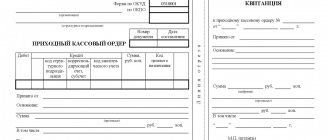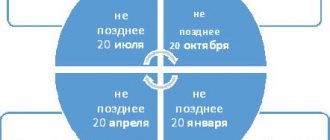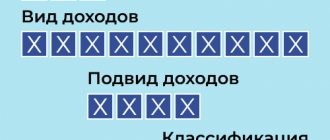For the social security of Russian citizens, a whole system of paying cash contributions to extra-budgetary funds has been developed.
Dear readers! The article talks about typical ways to resolve legal issues, but each case is individual. If you want to find out how to solve your particular problem , contact a consultant:
+7 (499) 938-81-90 (Moscow)
+7 (812) 467-32-77 (Saint Petersburg)
8 (800) 301-79-36 (Regions)
APPLICATIONS AND CALLS ARE ACCEPTED 24/7 and 7 days a week.
It's fast and FREE !
The calculation of these amounts is primarily the responsibility of accountants of various organizations, as well as individual entrepreneurs. To ensure that it runs without errors, a table of UST rates in 2021 was developed.
Total UST rate
Ordinary taxpayers are guided by the general size of the UST rate. Payments to the funds are made by employers for employees employed by the organization:
- the Pension Fund makes regular contributions in the amount of 22% of each employee’s earnings;
- 2.9% of earnings are allocated to the Social Insurance Fund to cover the costs of temporary disability, and 5.1% of earnings go to compulsory medical insurance.
The total amount of mandatory social tax is 30% of the earnings of each employee of the organization. If the organization’s activities are associated with the risk of harm to the health of workers, an additional injury tax is transferred to the Social Insurance Fund.
Who pays
Actually, all citizens who are officially employed on the territory of the Russian Federation are required to make contributions to the Unified Social Tax.
Based on the Tax Code (Article 419), insurance contributions should be made by the following groups of persons:
- individual entrepreneurs, as well as persons who are officially engaged in private practice;
- individuals who are not listed as individual entrepreneurs in the legal field, but still make payments to employees;
- legal entities (enterprises, organizations, etc.) that also have hired employees and pay them wages and other types of monetary remuneration.
The difference for the groups represented is the types of income that are subject to taxation.
The second and third groups are required to make deductions from all payments that were made in favor of individuals, no matter what type of agreement.
And the first group makes deductions from income only after it has made all the expenses that the current legislation provides for it.
Payments for individual entrepreneurs
Since the income of individual entrepreneurs is not stable, they are required to pay fixed amounts to the funds. Previously, the size of the unified social tax depended on the minimum wage, but in 2021 it gained stable specifics:
- 6884 rubles are transferred to compulsory medical insurance for individual entrepreneurs;
- in the Pension Fund of Russia – 29,354 rubles.
These fixed amounts apply to those individual entrepreneurs whose annual income does not exceed 300,000 rubles. If the established threshold is exceeded, the individual entrepreneur must pay an additional 1% of the remaining “excess” amount to the relevant funds.
Insurance premiums for individual entrepreneurs
The amount of fixed insurance premiums paid by entrepreneurs “for themselves” from 2021 does not depend on the contribution rate and the size of the minimum wage. Now individual entrepreneurs pay the amount determined by the Government of the Russian Federation, which in 2021 is 32,385 rubles, including:
- RUB 26,545 – for pension insurance;
- RUB 5,840 - for health insurance.
With income exceeding 300 thousand rubles, an individual entrepreneur is obliged to pay an additional 1% pension insurance contribution, while the total amount of Pension Fund contributions for the year should not exceed 212,360 rubles (Article 430 of the Tax Code of the Russian Federation).
Rates for various activities
The Tax Code regulates certain benefits that are provided to a number of taxpayers when calculating the unified social tax in 2021. Thus, in 2021, the following categories of organizations can reduce their rates:
- organizations located in the free economic zone of Crimea and Sevastopol;
- residents of the so-called districts “advanced development”;
- LLC and individual entrepreneur with a pharmaceutical license for UTII;
- LLCs and individual entrepreneurs with income below 79 million rubles according to the simplified tax system;
- Individual entrepreneurs working on patent taxation;
- charitable organizations on the simplified tax system;
- non-profit social organizations working in the fields of culture, medicine, education);
- organizations working in the field of recreation, tourism, IT and technology implementation.
A complete list of taxpayers applying for preferential rates under the UST in 2021, as well as their exact amount, is presented on the Federal Tax Service website. It is important that the tariffs are valid if the organization belongs to the OKVED category, which will need to be confirmed by a certificate and a corresponding application submitted to the FSS.
VNiM
The list of contributions included in the Unified Social Tax for 2021 also includes payments for temporary disability and maternity. In case of illness or maternity leave, these funds are paid to employees from the Social Insurance Fund.
In addition to the listed contributions, a number of organizations are required to transfer contributions to the Social Insurance Fund for injuries and possible occupational diseases. You can find out whether an LLC belongs to the category and find out the size of the added part of the unified social tax using the OKVED code, as well as the occupational risk classes existing at the enterprise. The additional rate for injuries for different organizations ranges from 0.2 to 8.5%.
What is the Unified Social Tax in 2021 and why is it needed?
UST stands for “single social tax”. Legally, such a tax has not existed since 2010. In the old fashioned way, accountants call them mandatory contributions to social, pension and health insurance.
In accordance with the requirements of Article 419 of the Tax Code of the Russian Federation, insurers are required to make social contributions, i.e. persons directly making payments and other benefits to employees:
- enterprises;
- Individual entrepreneurs and private practitioners;
- individuals.
The UST is intended to provide working citizens with state pensions and a number of additional payments in the future. It allocates the amounts necessary to provide free medical care and provide benefits.
Submitting reports
Calculations in the form of reports for the previous period are submitted to the Federal Tax Service on a monthly basis before the 30th of the current month. That is, at the end of September you need to transfer data to the tax office for August for each employee.
Only information on injury risks is submitted to the Social Insurance Fund, that is, on those employees whose position is associated with the possibility of occupational diseases or injuries. Reports with calculations are transferred to the fund in paper or electronic form before the 20th day of the current month for the previous period.
What is the maximum amount
The maximum that employers are required to pay for insurance is approved by the Government annually. 2021 brings some expected changes. Now the maximum contributions to the Pension Insurance Fund cannot exceed 1 million 21 thousand rubles. And social contributions cannot rise above 815 thousand rubles.
If payments have reached the maximum amount, they must be adjusted. For example, provided that the contributions are less than 1 million 21 thousand rubles, then the percentage charged is 22, and if more, it is already 10%.
Accordingly, social contributions up to 815 thousand rubles require a deduction of 2.9%, and if they are higher, then the rate becomes zero. There is no maximum payout for health insurance in 2020.
How to calculate tax
The UST calculation is carried out monthly for each employee separately, after which a general statement is drawn up, highlighting the amount for the enterprise as a whole. The statement is formed on an accrual basis: each column indicates how much employees have received since the beginning of the calendar year and 30% paid under the Unified Social Tax is calculated from these funds.
If necessary, the calculation can be made separately:
- Calculate part of the UST in the amount of 22% for the pension fund for each employee, based on his earnings from the beginning of the calendar year.
- Calculate the part of the unified social tax for compulsory medical insurance in the amount of 5.1%.
- Calculate the part of the unified social tax for VNiM in the amount of 2.9%.
- Subtract the funds already paid to the Federal Tax Service this year from the generated amounts and obtain the balance required for transfer to the budget.
Upon completion of settlements, funds that were previously paid to the Federal Tax Service under the Unified Social Tax are subtracted from the amount received. The remainder must be transferred to the budget within the time limits established by law.
A separate injury report is created, which includes the salary of employees exposed to risk at work. Based on the category, the required percentage should be allocated from the amount.
Calculator
In large organizations, experienced accountants are involved in calculating the unified social tax and transferring funds to the budget, while small firms and individual entrepreneurs that do not have specialists on staff can contact the Federal Tax Service website. Here is a convenient calculator with which in two clicks you can find out the exact amount of contributions required for the transfer.
Go to the page and enter the tax period and income for the specified periods in the empty fields. The system will automatically make calculations and display the result in the form of a table, which will contain the amounts for the Unified Social Tax, as well as the current BCC codes.
The online calculator on the Federal Tax Service website calculates the UST using a standard algorithm. Taxpayers belonging to preferential categories or who have exceeded the amount of payments must calculate the amount of contributions using other algorithms.
Unified social tax
The unified social tax is a tax intended to mobilize funds in order to realize the rights of citizens to state and social security (insurance) and medical care.
Taxpayers are recognized as:
1) persons making payments to individuals: organizations; individual entrepreneurs; individuals who are not recognized as individual entrepreneurs;
2) individual entrepreneurs, lawyers.
For tax purposes, members of a peasant (farm) enterprise are treated as individual entrepreneurs.
If a taxpayer simultaneously belongs to several categories of taxpayers specified in paragraphs 1 and 2, he calculates and pays tax on each basis.
A. The object of taxation for taxpayers specified in paragraphs two and three of paragraph 1 above is recognized as payments and other remuneration accrued by taxpayers in favor of individuals under employment and civil law contracts, the subject of which is the performance of work, the provision of services (with the exception of remunerations paid to individual entrepreneurs), as well as under copyright agreements. The object of taxation for the taxpayers specified in paragraph four of clause 1 are payments and other remuneration under employment and civil law contracts, the subject of which is the performance of work, the provision of services, paid by taxpayers in favor of individuals. Payments made within the framework of civil contracts, the subject of which is the transfer of ownership or other proprietary rights to property (property rights), as well as contracts related to the transfer of property (property rights) for use, do not apply to the object of taxation.
B. The object of taxation for taxpayers specified in paragraph 2 above is income from entrepreneurial or other professional activities minus expenses associated with their extraction.
B. For taxpayers who are members of a peasant (farm) enterprise (including the head of a peasant (farm) enterprise), expenses actually incurred by the said enterprise related to the development of the peasant (farm) enterprise are excluded from income.
The payments and remunerations specified in paragraph A (regardless of the form in which they are made) are not recognized as an object of taxation if:
- for taxpayer organizations, such payments are not classified as expenses that reduce the tax base for corporate income tax in the current reporting (tax) period;
- For taxpayers - individual entrepreneurs or individuals, such payments do not reduce the tax base for personal income tax in the current reporting (tax) period.
The tax base of taxpayers - individual entrepreneurs and individuals not recognized as individual entrepreneurs is determined as the amount of payments and other remuneration provided for in paragraph A (above), accrued by the taxpayer for the tax period in favor of individuals.
When determining the tax base, any payments and remuneration are taken into account (except for the amounts specified in Article 238 of the Tax Code of the Russian Federation), regardless of the form in which these payments are made, full or partial payment for goods (work, services, property or other rights), intended for an individual - an employee or members of his family, including utilities, food, recreation, training in their interests, payment of insurance premiums under voluntary insurance contracts (except for the amounts of insurance premiums specified in subclause 7 of clause 1 of Art. 238 of the Tax Code of the Russian Federation). The calculation of the tax base for other categories of taxpayers is set out in Art. 237 Tax Code of the Russian Federation. For individual entrepreneurs using a simplified taxation system, the tax base is determined as the product of gross revenue and a coefficient of 0.1.
When calculating the tax base, payments and other remuneration in kind in the form of goods (work, services) are taken into account as the cost of these goods (work, services) on the day of their payment, calculated on the basis of their market prices (tariffs), and in case of state regulation of prices ( tariffs) for these goods (works, services) - based on state regulated retail prices. In this case, the cost of goods (works, services) includes the corresponding amount of value added tax, and for excisable goods, the corresponding amount of excise taxes.
In accordance with Art. 238 PC of the Russian Federation are not subject to taxation:
1) state benefits paid in accordance with the legislation of the Russian Federation, legislative acts of the constituent entities of the Russian Federation, decisions of representative bodies of local self-government, including temporary disability benefits, benefits for caring for a sick child, unemployment benefits, pregnancy and childbirth benefits;
2) all types of compensation payments established by the legislation of the Russian Federation, legislative acts of the constituent entities of the Russian Federation, decisions of representative bodies of local self-government (within the limits of the norms established in accordance with the legislation of the Russian Federation) related to:
- compensation for harm caused by injury or other damage to health;
- free provision of residential premises and utilities, food and products, fuel or appropriate monetary compensation;
- payment of the cost and (or) issuance of the due allowance in kind, as well as payment of funds in exchange for this allowance;
- payment for the cost of food, sports equipment, equipment, sports and dress uniforms received by athletes and employees of physical education and sports organizations for the educational and training process and participation in sports competitions;
- dismissal of employees, including compensation for unused vacation;
- reimbursement of other expenses, including expenses for improving the professional level of employees;
- employment of employees dismissed due to measures to reduce numbers or staff, reorganization or liquidation of the organization;
- performance of work duties by an individual (including moving to work in another area and reimbursement of travel expenses).
3) the amount of one-time financial assistance provided by the taxpayer:
to individuals in connection with a natural disaster or other emergency circumstance in order to compensate for the material damage caused to them or harm to their health, as well as to individuals who suffered from terrorist acts on the territory of the Russian Federation; family members of a deceased employee or an employee in connection with the death of a family member(s);
4) amounts of wages and other amounts in foreign currency paid to its employees, as well as to military personnel sent to work (service) abroad, by a taxpayer financed from the federal budget by state institutions or organizations - within the limits established by the legislation of the Russian Federation;
5) income of members of a peasant (farm) enterprise received in this enterprise from the production and sale of agricultural products, as well as from the production of agricultural products, their processing and sale - for five years starting from the year of registration of the enterprise;
6) income (except for wages of hired workers) received by members of tribal and family communities of small peoples of the North registered in the established manner from the sale of products obtained as a result of their traditional types of fishing; amounts of insurance payments (contributions) for compulsory insurance of employees;
7) the cost of travel benefits provided by the legislation of the Russian Federation to certain categories of employees, students, and pupils;
 payments in cash and in kind, made from trade union dues to each trade union member, provided that these payments are made no more than once every 3 months and do not exceed 10 thousand rubles. in year;
payments in cash and in kind, made from trade union dues to each trade union member, provided that these payments are made no more than once every 3 months and do not exceed 10 thousand rubles. in year;
9) other payments in accordance with Art. 238 Tax Code of the Russian Federation.
The following are exempt from taxes:
1) organizations of any organizational and legal forms - from the amounts of payments and other remuneration not exceeding 100 thousand rubles during the tax period. for each employee who is a disabled person of groups I, II, III;
2) the following categories of taxpayers-employers - from amounts of payments and other remuneration not exceeding 100 thousand rubles. during the tax period for each individual employee:
- public organizations of disabled people (including those created as unions of public organizations of disabled people), among whose members disabled people and their legal representatives make up at least 80%, their regional and local branches;
- organizations whose authorized capital consists entirely of contributions from public organizations of disabled people and in which the average number of disabled people is at least 50%, and the share of wages of disabled people in the wage fund is at least 25%;
- institutions created to achieve educational, cultural, medical and recreational, physical culture, sports, scientific, information and other social goals, as well as to provide legal and other assistance to people with disabilities, disabled children and their parents, the sole owners of whose property are these public organizations disabled people.
The benefits specified in this paragraph do not apply to taxpayers engaged in the production and (or) sale of excisable goods, mineral raw materials, other minerals, as well as other goods in accordance with the list approved by the Government of the Russian Federation on the proposal of all-Russian public organizations of disabled people;
3) other categories of taxpayers in accordance with Art. 239 Tax Code of the Russian Federation.
The tax period is a calendar year. Tax reporting periods are the first quarter, six months and nine months of the calendar year.
For taxpayers (employers) - organizations, individual entrepreneurs and individuals not recognized as individual entrepreneurs, with the exception of taxpayers acting as employers - agricultural producers and tribal, family communities of small peoples of the North engaged in traditional economic sectors, the following rates apply.
If at the time of payment of advance tax payments by taxpayers-employers, the amount of the tax base accumulated since the beginning of the year on average per individual, divided by the number of months elapsed in the current tax period, amounts to less than 2,500 rubles, the tax is paid at the maximum rate, regardless of the actual size of the tax base for each individual. Taxpayers whose tax base meets the criterion specified in this paragraph do not have the right to use a regressive tax rate scale until the end of the tax period. When calculating the average tax base per employee for taxpayers with more than 30 employees, payments in favor of 10% of employees with the largest income are not taken into account, and for taxpayers with 30 employees (inclusive) payments in favor of 30% are not taken into account. workers with the highest incomes.
For taxpayers - individual entrepreneurs who do not hire workers, and heads of members of peasant (farm) households, the following tax rates apply.
The procedure for calculating and deadlines for paying taxes by taxpayers-employers is established by Art. 243 Tax Code of the Russian Federation.
D.V. Krivopalov [email protected] ngs.ru






